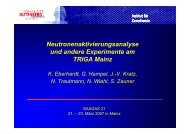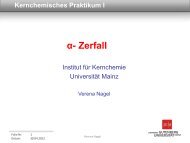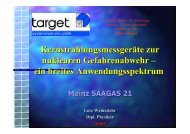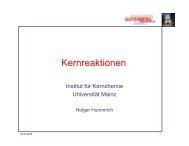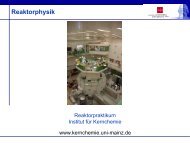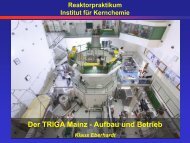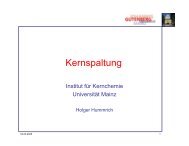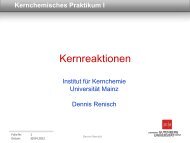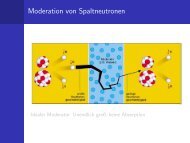jahresbericht 2007 - Institut für Kernchemie - Johannes Gutenberg ...
jahresbericht 2007 - Institut für Kernchemie - Johannes Gutenberg ...
jahresbericht 2007 - Institut für Kernchemie - Johannes Gutenberg ...
You also want an ePaper? Increase the reach of your titles
YUMPU automatically turns print PDFs into web optimized ePapers that Google loves.
Determination of K d values of 44 Ti and 44 Sc<br />
in HCl/H 2 C 2 O 4 solution of various concentrations<br />
D.V. Filosofov 2 , N.S. Loktionova 1 , F. Rösch 1<br />
1 <strong>Institut</strong>e of Nuclear Chemistry, University of Mainz, Mainz, Germany<br />
2 Joint <strong>Institut</strong>e of Nuclear Research, DLNP, 141980 Dubna, Russian Federation<br />
Introduction: For preparation of<br />
44 Ti/ 44 Sc<br />
radionuclide generators, several radiochemical<br />
criteria are relevant, such as effective separation<br />
strategies providing high Sc yields and low Ti<br />
breakthrough, high long-term stability, and type of Sc<br />
eluates useful for subsequent labelling reactions (i.e.<br />
low volume, low pH, high purity etc.). In this study,<br />
ion exchange experiments have performed<br />
systematically using AG-1x8 (200-400 mesh Cl - -<br />
form) and AG-50x8 (200-400 mesh H + -form) resin in<br />
H 2 C 2 O 4 /HCl solution in order to evaluate the<br />
potential of ion exchange-based generators.<br />
Experimental: K d values for both Sc and Ti were<br />
determined in batch experiments using different<br />
concentrations of HCl / oxalic acid mixtures.<br />
44 Ti( 44 Sc) and 46 Sc were used as isotopic tracers for<br />
Ti(IV) and Sc(III) distributions.<br />
44 Ti( 44 Sc) was<br />
prepared as described earlier [1]. 46 Sc was produced<br />
via γ-reaction on natural Sc at the HMI Berlin<br />
reactor. A stock solution of 44 Ti (30 KBq) and 46 Sc (1<br />
mg, 20 mCi) was dried and dissolved in 100 µl 0.1 M<br />
H 2 C 2 O 4 (solution X).<br />
Aliquots were prepared in Eppendorf 1.5 ml vials<br />
with 100 mg of AG-1x8 (200-400 mesh Cl - -form) or<br />
AG-50x8 (200-400 mesh H + -form). To all probes 1<br />
ml of HCl/H 2 C 2 O 4 mixture was added. Than 5 µl of<br />
solution X was added to probes 1-9 and they were<br />
shaken during 2 days.<br />
Another solution Y – a probe with 44 Ti (117 KBq)<br />
with the remaining solution of X and 46 Sc were dried<br />
and dissolved in 0.025 M H 2 C 2 O 4 . 5 µl of solution Y<br />
was added to probes 10-16 and they were shaken<br />
during 2 days. Another solution Z was prepared – a<br />
probe with 44 Ti (27 KBq) with the rest of solution Y<br />
and 46 Sc dried and dissolved in 0.005 M H 2 C 2 O 4 . 5 µl<br />
of solution Z was added to probes 17-26 and they<br />
were shaken during 2 days.<br />
K d was calculated by<br />
K d = (4A-10A’)/A’<br />
A – activity of a whole probe with resin<br />
A’ – activity of 400 µl sample of a probe after ionexchange<br />
reaction<br />
Results and Discussion:<br />
Results of the K d values obtained for the two<br />
different ion exchange resins and the various<br />
mixtures are shown in table 1.<br />
Table 1. Distribution coefficents of Ti(IV) and Sc(III) in HCl /<br />
oxalic acid mixtures for cation and anion exchange resins<br />
X<br />
Y<br />
Z<br />
N Concentration of<br />
K d<br />
solution, mol/l AG-50x8 AG-1x8<br />
H 2C 2O 4 HCl Ti Sc Ti Sc<br />
1 0.1 0 - - >1000 184<br />
2 0.1 0.05 - - >1000 41<br />
3 0.1 0.1 - - >1000 14<br />
4 0.1 0.15 1000 5.1<br />
5 0.1 0.20 1000 1.7<br />
6 0.1 0.30 1000 67.2<br />
19 0.005 0.0375 34.2 2242 >1000 24.0<br />
20 0.005 0.05 33.6 2665 >1000 10.9<br />
21 0.005 0.065 28.2 1872 >1000 4.0<br />
22 0.005 0.08 33 1715 844 1.27<br />
23 0.005 0.10 33 1646 688 0.71<br />
24 0.005 0.125 25.6 1398 457



